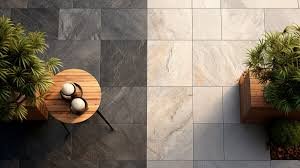A patio is one of the most important features of a garden. It is a place to relax on summer evenings, host family gatherings, or simply step outside and enjoy the fresh air. The choice of material for a patio makes all the difference to both the look and the performance of the space. Among the most popular options in the UK are natural stone and porcelain. Both bring their own advantages and challenges, and both offer a distinct character that influences the style of the whole garden. Understanding how each performs, how they cope with the British climate, and what they bring in terms of maintenance and cost will help you decide which is best for your home.
The Character of Natural Stone
Natural stone patios have a timeless quality. Sandstone, limestone, granite and slate are some of the most common choices, each with its own textures and tones. The appeal lies in their individuality. No two pieces are exactly alike, and the variations in colour and pattern create a surface that feels authentic and rooted in tradition. In period properties and country-style gardens, natural stone complements the character of the house and blends easily with the surrounding landscape.
The performance of natural stone depends on the type used. Sandstone, for example, is softer and more porous, which makes it easier to work with but also more vulnerable to weathering. Granite, on the other hand, is dense and durable, capable of withstanding heavy use and extremes of temperature. Limestone sits somewhere in between, providing a smooth, elegant finish but requiring sealing to maintain its appearance. Whatever the choice, natural stone is always tactile and full of visual interest.
The Appeal of Porcelain
Porcelain is a manufactured material that has grown rapidly in popularity for patios across the UK. Produced at high temperatures, porcelain tiles are dense, non-porous and extremely durable. The biggest advantage is consistency. Unlike natural stone, porcelain comes in uniform sizes, colours and finishes, allowing for precise installation and a sleek, modern look. Advances in manufacturing mean porcelain can now be printed with realistic stone or wood effects, offering the beauty of natural materials without some of the drawbacks.
Porcelain is particularly resistant to staining and weathering. Spilt wine, oil or muddy footprints can be wiped away easily, and the surface does not absorb moisture. This makes it an appealing option for busy households where maintenance time is limited. It also resists moss and algae growth more effectively than porous surfaces, ensuring the patio looks fresher for longer with minimal upkeep.
Coping with the British Climate
The UK’s climate tests any patio material. Rain is frequent, frosts are common in winter, and summers, though short, can be hot enough to affect surfaces. Natural stone responds differently depending on its type. Porous stones like sandstone absorb water, which then freezes and expands during cold snaps, leading to gradual deterioration. Darker stones like slate and granite cope better with frost but can fade slightly under strong sunlight. Regular sealing reduces these vulnerabilities, but natural stone requires ongoing attention to stay in peak condition.
Porcelain’s density makes it almost completely resistant to moisture penetration. This means frost has little effect, and water drains away without leaving marks. UV resistance is another strength, ensuring that colour remains stable even under prolonged sunlight. For homeowners who want to minimise the impact of the weather, porcelain is a practical choice. However, its very hardness can sometimes make it more slippery in wet conditions if the surface finish is too smooth, though textured varieties are available to reduce this risk.
Installation Considerations
How a patio is installed has a major influence on its long-term performance. Natural stone is relatively forgiving to work with, as each slab can be adjusted to fit irregularities in the ground. However, its weight and varying thickness require a skilled hand to achieve an even finish. Because natural stone is porous, it must be laid on a suitable base that prevents rising damp and minimises staining from beneath.
Porcelain, by contrast, demands precision. The tiles are thinner and more uniform, but they need to be cut accurately with specialist equipment and installed with the right adhesives and grouts. A small mistake during installation can undermine the clean, modern effect that porcelain is known for. Professional installation is usually recommended for both materials, but particularly for porcelain where the tolerance for error is lower.
Maintenance and Longevity
Maintenance is one of the areas where natural stone and porcelain differ most. A natural stone patio requires periodic sealing to protect against stains, frost damage and moss growth. Without it, the surface can weather quickly, especially in damp or shaded gardens. Regular cleaning with a pressure washer helps keep the stone looking its best, but care must be taken not to damage softer varieties. For those who enjoy the rustic, aged appearance of stone, the gradual changes in colour and texture may be seen as part of its charm.
Porcelain is much easier to care for. Its non-porous nature means sealing is unnecessary, and a simple wash with soapy water or a hose is usually enough to restore its appearance. Because it does not fade, stain or absorb water easily, porcelain can look almost as good after ten years as it did when first installed. Its longevity, combined with minimal maintenance requirements, is one of the main reasons it has become so popular with modern homeowners.
Style and Aesthetics
Choosing between natural stone and porcelain often comes down to style. Natural stone conveys character and tradition. Each slab tells its own story, with markings and variations that create a patio full of life and individuality. It suits cottages, period homes and gardens designed to feel organic and rustic. Even in modern homes, natural stone can add a touch of timeless charm that softens contemporary architecture.
Porcelain offers sleekness and precision. It provides the kind of finish associated with modern living, with crisp lines and consistent tones. For contemporary homes, porcelain creates outdoor spaces that feel like extensions of the interior, especially when matching tiles are used indoors. It is also versatile in style, as manufacturers produce tiles that mimic the look of natural stone, wood or even concrete. For those who want control over colour and pattern, porcelain provides endless options.
Cost and Value
Cost is an important factor for many homeowners. Natural stone varies widely in price depending on the type and source. Locally sourced sandstone may be relatively affordable, while imported granite or rare limestone can be expensive. Porcelain is also available across a wide price range, though installation costs are often higher because of the precision and tools required.
In terms of value, both materials can enhance a property. A well-maintained natural stone patio is highly desirable for buyers looking for character, while a porcelain patio appeals to those who want modern convenience and low maintenance. Over the long term, porcelain may prove more cost-effective due to its durability and reduced upkeep, but natural stone retains a timeless appeal that can also translate into value.
Making the Right Choice
There is no single answer to the question of whether natural stone or porcelain is the right patio material. The decision depends on the style of the home, the character of the garden, the amount of maintenance the homeowner is willing to undertake, and the budget available. For some, the authenticity and warmth of natural stone will always win. For others, the clean lines and practicality of porcelain are too compelling to ignore.
Both materials are capable of creating beautiful patios that provide years of enjoyment. The key is to choose with an understanding of how each performs in the UK climate, how it is installed, and how it will look after years of use. By weighing these considerations carefully, homeowners can create a patio that not only enhances their outdoor space but also reflects their lifestyle and personality.







